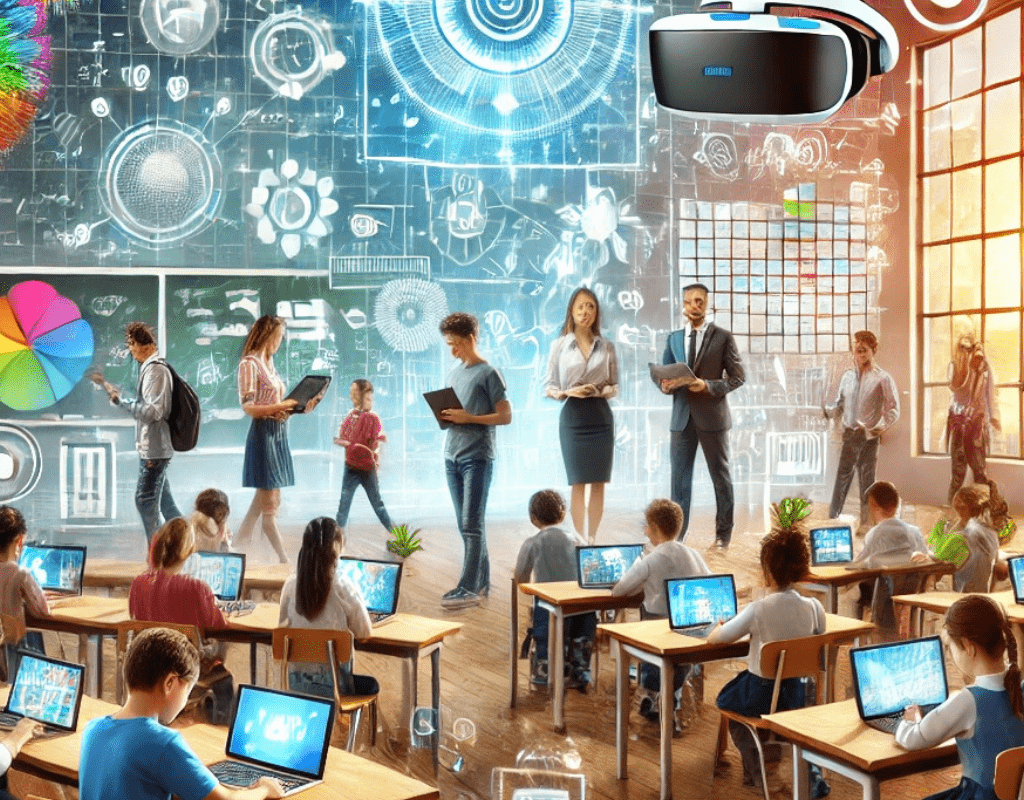Artificial intelligence (AI) in education is a transformative power that alters the fundamental foundation of education, not just a term in the realm of technology. The way artificial intelligence is affecting classrooms, instructors, and students as we move further into 2025 is truly remarkable. From customized instruction to simplified administration, artificial intelligence is bringing about positive change and opening up new opportunities for students everywhere. Supported by the latest trends, actual case studies, and professional perspectives, this blog post will explore seven remarkable ways artificial intelligence is transforming education.
1. Personalised Learning: Customising Instruction for Every Student
The capacity of artificial intelligence to provide very tailored learning experiences is the most praised advantage it offers for education. AI-powered systems examine every student’s skills, weaknesses, speed, and preferences to develop unique learning pathways unlike conventional, one-size-fits-all instruction. This ensures that as advanced students are challenged with progressively more difficult content, struggling students receive additional support.
Personalized learning powered by artificial intelligence has improved student learning outcomes by 73% and its efficacy by 89%.
DreamBox, Khan Academy, and Century Tech, among other tools, utilize adaptive algorithms to provide instant feedback and focus resources by adjusting material in real time.
Output: Result: Students pick up fundamental ideas quicker; learning gaps are reduced by 78%; and satisfaction scores climb to 91%.
2. Intelligent Tutoring Systems: 24/7 Support with instantaneous feedback
Intelligent tutoring systems (ITS) of AI in education, driven by artificial intelligence (AI), function as virtual teachers, always accessible. Without regard for human availability, these tools provide instantaneous feedback, answers to inquiries, and help pupils navigate challenging ideas.
While Cognii’s conversational artificial intelligence helps students improve critical thinking with open-ended responses, Amira Learning accelerates reading comprehension by listening to pupils read aloud and providing personalized feedback.
Students benefit from ongoing assistance, which accelerates skill development by up to 82% and boosts confidence.

3. Administrative Effectiveness and Automated Assessment
Many times, teachers grade assignments, check attendance, and handle schedules, time that could be better spent connecting with their pupils. By adopting AI in education for these administrative tasks, artificial intelligence is transforming them and significantly reducing operating expenses and effort.
Thanks to AI in education, institutions document an 87% decrease in administrative burden.
AI grading solutions provide quick, objective feedback; scheduling tools maximize class schedules; and platforms like Nuance transcribe lectures for students with particular needs.
Output Result: Schools run more effectively, and teachers recover precious time for AI in education.
4. Predictive analytics—active student support
The data-crunching capability of artificial intelligence helps teachers identify which children are at risk of dropping out or falling behind. AI technologies can identify children who need attention by analyzing attendance, grades, and engagement data, often before issues become apparent.
Platforms such as Kidaptive employ artificial intelligence to identify learning trends and predict future performance, thereby enabling instructors to customize tools and support.
Early intervention produces better retention rates and more effective learning paths.
5. AI in Education – Accessible and inclusive learning
Through helping students with various requirements, artificial intelligence is making education more inclusive. While AI-powered language programs like Blue Canoe aid non-native speakers with pronunciation and fluency, speech recognition software such as Nuance assists pupils with writing problems.
Blippar and other augmented reality (AR) tools utilize artificial intelligence and augmented reality to offer interactive, visual learning opportunities that simplify complex subjects for all students.
AI adjusts materials for students with impairments, ensuring everyone has an equitable opportunity to excel.
6. Improved Motivation and Engagement
Offering interactive materials, gamified courses, and real-time progress monitoring, AI-driven systems keep students engaged and motivated. This instantaneous feedback loop drives students to keep on target and acknowledge their successes. [3[5].
The step-by-step comments of Thinkster Math and Quizlet’s AI-powered study programs keep students engaged and committed to their education.
Results: Higher satisfaction ratings and improved academic achievement follow from more participation.
7. Empowering Teachers: Content Creation and Lesson Planning Done Right
AI in education is a valuable resource for instructors, not just for children. From creating bespoke quizzes and assignments to recommending a course of action based on class performance data, artificial intelligence technologies enable teachers to give more successful training.
Key Stat: 50% of instructors now organize their lessons using artificial intelligence, while 94% of universities utilize AI-powered learning analytics.
Content Generation: For complex topics, AI may even design interactive simulations and organize resources and recommendations for more content through AI in education.
Output: Result: While artificial intelligence performs the hard work behind the scenes, teachers can concentrate on what they do best—inspiring and leading pupils through AI in education.
Practical Illustrations of AI in Use
Let’s underline some notable artificial intelligence uses generating waves in the field of education:
| AI Tool/Platform | Functionality | Benefit |
| DreamBox, Khan Academy | Adaptive learning paths | Personalized, self-paced learning |
| Nuance | Speech recognition for lectures and writing | Accessibility for special needs |
| Amira Learning | Reading fluency assessment | Early detection of reading challenges |
| Blippar | AI + AR for interactive lessons | Visual, immersive learning |
| Quizlet | AI-driven study plans | Efficient, targeted revision |
| Thinkster Math | AI + human tutoring for math | Customized feedback and improvement |
| Kidaptive | Predictive analytics for student support | Early intervention |
Challenges and Considerations.
Difficulties and Considerations
Although the advantages of AI in education are substantial, incorporating artificial intelligence into education presents difficulties:
Many teachers lack the training necessary to effectively utilize AI technologies, resulting in underutilization and sometimes misuse.
Particularly in rural or underdeveloped regions, economic differences imply that not all students have equal access to AI-enhanced learning.
Real concerns include data privacy, algorithmic bias, and over-reliance on artificial intelligence for assignments, which necessitate strong rules and monitoring.
In certain areas, poor technical infrastructure restricts the accessibility of AI-powered solutions.
The Future: Growing Function of AI in Education
As artificial intelligence continues to develop, its influence on education will only become increasingly important. With fresh ideas on hand, the worldwide market for artificial intelligence in education is estimated to reach $20 billion by 2027.
Emerging trends include artificial intelligence-driven virtual and augmented reality experiences that facilitate immersive learning.
Safe, verifiable digital credentials are formed on the blockchain for certification.
Bite-sized AI-curated courses for mobile learning.
– Sustainability: AI-driven courses that stress world issues.
Conclusion: An Incredible Learning Age
For education, artificial intelligence is ushering in an incredible period when learning is more individualized, inclusive, and prosperous than ever before. Teachers and institutions can ensure that every child benefits from this technological transformation by embracing AI’s possibilities while addressing its challenges.
Whether your role is teacher, student, parent, policymaker, or otherwise, now is the moment to investigate, embrace, and promote AI-powered solutions that simplify learning through engagement, accessibility, and meaningful impact. AI will drive the direction of education going forward.




